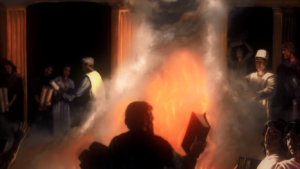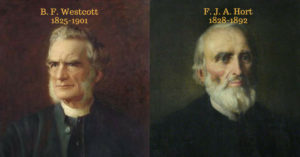The Majority Text Bible
 THE MAJORITY TEXT BIBLE
THE MAJORITY TEXT BIBLE
Why are different translations of the Bible… different?
For example, Psalm 12, verse 6 to 7.
The King James says:
“The words of the Lord are pure words: as silver tried in a furnace of earth, purified seven times.
Thou shalt keep them, O Lord, thou shalt preserve them from this generation for ever.”
But the New International Version says:
“And the words of the Lord are flawless,
like silver purified in a crucible,
like gold refined seven times.
You, Lord, will keep the needy safe
and will protect us forever from the wicked.”
Question: are these two translations differing only in expression, or are they conveying two completely different meanings here? Which was God promising to preserve in this verse: the needy, or His Word?
Another place, in the New Testament, in the book of Revelation, chapter 22 verse 14.
 The King James says: “Blessed are they that do His commandments, that they may have right to the tree of life, and may enter in through the gates into the city.”
The King James says: “Blessed are they that do His commandments, that they may have right to the tree of life, and may enter in through the gates into the city.”
But the NIV says: “Blessed are those who wash their robes, that they may have the right to the tree of life and may go through the gates into the city.”
Are Christians supposed to “wash their robes”, or keep the Ten Commandments of God here? Can we just profess the Lord Jesus Christ on our mouth, and then steal, lie, kill, cheat to our hearts’ content, knowingly disobey the Ten Commandments, and still be saved?
Obviously, there is only one Bible, but these translations are not saying the same thing, with differences so severe that they even tremendously impact the doctrines being taught. And not just in a few places. What’s going on? How do we identify the correct version of the Word of God?
 To answer these questions, we need to know the story behind the original texts from which these versions were translated.
To answer these questions, we need to know the story behind the original texts from which these versions were translated.
Right after the commencement of the age of Jesus Christ our Lord, His persecuted believers were scattered all over the 3 continents: Asia, Africa, and Europe. Of course, they copied the entire Bible – the books of the Old Testaments, and the epistles of the New Testament – and carried the Scriptures with them. Back then, there were no printing press. In order to copy a Bible, you have to hand-copy the whole thing. And that work took on average about 10 months per copy.
 In the next 1000 years, despite the withering persecution against the saints, even to the point that if they are caught, both them AND their Bible will be sentenced to the flame, countless Bible manuscripts in the original languages still survive.
In the next 1000 years, despite the withering persecution against the saints, even to the point that if they are caught, both them AND their Bible will be sentenced to the flame, countless Bible manuscripts in the original languages still survive.
Around the 15th century, people started to gather these Bible manuscripts from all over the world, compare them to one another, and realize: except a very small amount of manuscripts that contradict one another, the majority of them are almost exactly the same, differing only in the spelling of a few words. Spellings like, Peter vs Pedro, which can be easily identified.
The amazing thing is that many of these manuscripts were copied by churches that did not even know each others existed – some were copied in Northern Europe, some were copied in Asia, some were copied in central Africa – and thus they could not possibly be copying from one another. Yet their copies still match!
Now, can their copies match, and yet still be incorrect? Can all of them made ALL the EXACT SAME MISTAKES in their copying of the text, through the countless times they copied the Bible through the ages?
Obviously not.
If they made mistakes, their manuscripts will immediately NOT match.
So if their manuscripts match, they must have ACCURATELY copied the Bible since they received it from the apostle down to their time.
If by the time of the translation of the legendary English King James, the translators had only managed to find a handful of copies and compiled them into the Textus Receptus, nowadays we have found over 5000 such manuscripts, from different centuries, from different churches, separated from one another, yet still match. They are called the Majority Text – the very Bible manuscript that was protected by the Lord and baptized in the blood of millions of matyrs who have laid down their lives to preserve it for future generations.
These 5000+ manuscripts not only are the miraculous proof that the Lord has INDEED been keeping His Bible intact, just as He declared in Psalm 12:6-7, but also helped discover and resolve the few last mistakes in the Textus Receptus of the King James, happened partly because back then the translators had so few original manuscripts to compare.
 Now, while all of this was happening, down in Alexandria, a city in Egypt of all places, there was a group calling themselves Christians. However, this group did not believe in a lot of the fundamental doctrines of Jesus, but had their own set of beliefs. Neither did they believe in the infallibility of the Holy Scriptures, that it cannot be altered or edited. And thus, in order to resolve the differences between the Bible and their denominational beliefs, they made up a Bible version of themselves to suit their own doctrines, altering about 6000 places in the Word of God that they didn’t like.
Now, while all of this was happening, down in Alexandria, a city in Egypt of all places, there was a group calling themselves Christians. However, this group did not believe in a lot of the fundamental doctrines of Jesus, but had their own set of beliefs. Neither did they believe in the infallibility of the Holy Scriptures, that it cannot be altered or edited. And thus, in order to resolve the differences between the Bible and their denominational beliefs, they made up a Bible version of themselves to suit their own doctrines, altering about 6000 places in the Word of God that they didn’t like.
Afterward, this group themselves copied the Bible edition that they altered. Three of those copies still survive until today. One was found in Alexandria, Egypt, called the Alexandrinus. One was found in the St. Catherine monastery in a place mistakenly called “Sinai peninsula”, the Sinaiticus. One is held in the Vatican library, called the Vaticanus. They are very, very old manuscripts, date back to the 4th century even, the oldest manuscripts that we have today.
However, all three of these manuscripts contain myriads of contradictions. They disagree with one another all over the place. That alone is enough to confirm the fact that they have been corrupted, even when they’re old.
 The monks of Vatican had translated the Sinaiticus of these Alexandrian texts into Latin many centuries ago, and called it the Latin Vulgate, which is the Latin Bible used by the Catholic church. That could be a very good translation, but still of a very bad manuscript.
The monks of Vatican had translated the Sinaiticus of these Alexandrian texts into Latin many centuries ago, and called it the Latin Vulgate, which is the Latin Bible used by the Catholic church. That could be a very good translation, but still of a very bad manuscript.
After that, in 1582, the Catholics continued to translate the Latin Vulgate into English, called the Confraternity Douay Rheims, to be used in the Catholic church. Once again, that could be a very good translation, but still of a very bad manuscript.
 And then two Greek scholars named Wescott and Hort came along. They took those three “old” manuscripts, thinking: “These are the oldest, therefore they must be the most accurate” – and merged them into one Greek manuscript, published in 1881 with a proud declaration: “This is the oldest and therefore most accurate original manuscript of the Bible”. Too bad. Because old only means old, doesn’t mean accurate.
And then two Greek scholars named Wescott and Hort came along. They took those three “old” manuscripts, thinking: “These are the oldest, therefore they must be the most accurate” – and merged them into one Greek manuscript, published in 1881 with a proud declaration: “This is the oldest and therefore most accurate original manuscript of the Bible”. Too bad. Because old only means old, doesn’t mean accurate.
But ever since, people have been leaping on this “oldest” manuscript and translate it into myriads of modern translations that we have today, and not just in English, but in pretty much every other languages in the world since then. They could be very good translations, but still of a TERRIBLE manuscript.
Thus we have the Catholic Bible translated from the Sinaiticus, while the Protestant Bibles are translated from various Alexandrian texts and the Westcott-Hort, which is the merging of the Sinaiticus with the other two corrupted manuscripts. That is why all these versions contradict. They were translated from contradicting manuscripts! But the problem is, none of them is the correct manuscript of the Bible, the Majority Text!
Basically, there are only 2 types of manuscripts. The first one is the Westcott-Hort and every related manuscript, originating from the three corrupted Alexandrian manuscripts that contradict one another all over the place, together with 46 pieces of scrap supporting them.
The second one is the text that was preserved by the Lord, existed throughout the length of church history to be accessed and used by the saints of all ages. Nowadays we have found over 5000 of matching manuscripts, and call them the Majority Text.

No further word needs to be said, in order to determine which one is the correct original text of the Bible.
To be fair, the Alexandrian translations in various languages, even though they contain many errors, still fulfilled their purpose of bringing many people to the Lord to be saved around the world, including me, and because of that, their service has been immensely valuable still.
While a Majority Text translation was still not available, reading the Alexandrian ones can still be beneficial; and the translators who created them can still absolutely be true Christians and faithful servants of the Lord according to the light they have received.
However, it is time the people of God get to possess a more accurate Bible translation. Accurate, not because the translator was any special, but just because the correct manuscript was used for the work.
Because the key in determining which translation is the correct one, isn’t in figuring out which translator was the best linguistically, but which manuscript is the correct one to be translated!
Since the Westcott-Hort are so numerous in errors (over 6000), I will only list down a few hundred most severe mistakes, hopefully that would be enough to convince you to choose the Majority Text.
Now, what about the few mistakes left in the King James, occured due to the translators back then only had access to so few manuscripts to compare and identify the errors?
Seriously. There were a few places where they didn’t even have any manuscripts, and had to make do with the current Bible versions of that time. Which were bad. Very bad.
Here are a few examples of such mistakes:
Luke 23:43. The King James says: “And Jesus said unto him, Verily I say unto thee, Today shalt thou be with me in paradise.”
This is the verse where Jesus addressed the thief who was nailed to the cross beside Him, who repented and believed in Him in his last hours.
Now, the original language of the New Testament was Greek. And this language has NO PUNCTUATION MARKS whatsoever. No period, no comma, nothing. When the King James theologians translated the Bible from this language, they had to come up with the punctuation marks and insert them into the sentences themselves. And sometimes, they put those marks in the wrong place, such as the case of Luke 23:43.
We can know for SURE that the comma before the word “today” in this verse was placed in the wrong spot, because of John 20:17.
“Jesus saith unto her, Touch me not; for I am not yet ascended to my Father.”
How could Jesus have been to Paradise on Friday when He died, if on Sunday morning when He rose from the dead, in the garden of His tomb, He still told Mary that He has NOT yet ascended to His Father.?
Note that according to Revelation 2:7, Heaven and Paradise are one and the same!
The Lord’s statement in [03] Luke 23:43 should have been read:
“Verily I say unto you today, you will be with me in Paradise.”
With the comma placed AFTER the word “today” instead of before it.
That is what the Lord meant. One day, that thief who repented in the last hour, along with all those who have sincerely believed in Christ, will receive the promise of everlasting life and get to be with JESUS in Paradise, but that day is NOT the Friday when he died.
This one mistake should not surprise us, because while all the divinely inspired manuscripts that were correctly copied will be divinely protected, the translations are not. Translators are NOT the prophets and apostles who were taken over by the Spirit of the Lord to write His Bible. They are not infallible, and can still make mistakes. Mistakes that we can reasonably identify and correct.
One more mistake worth mentioning of the King James, and perhaps the most severe and well-known corruption of them all, is the infamous Comma Johanneum – the added text of John – in I John chapter 5 verse 7 to 8.
The Majority Text reads:
“For there are three that bear witness: the spirit, and the water, and the blood: and these three agree in one.”
But the King James added a whole bunch of text:
“For there are three that bear record in heaven, the Father, the Word, and the Holy Ghost: and these three are one. And there are three that bear witness in earth, the Spirit, and the water, and the blood: and these three agree in one.”
Eramus – who compiled the Textus Receptus – could not find one single Greek manuscript that has this “Comma Johanneum” (added text of John) and had intended not to put it in. But the Catholic church back then – even though they could provide only one manuscript (Codex Montfortianus – GA 61) that dated even to the XV century – had compeled Eramus to put it in. And he did. Nowadays we can confirm that this added text really was added, nowhere found in the Majority Text manuscripts.
Having said that, despite all these errors that must be fixed, as the translator of the Vietnamese Majority Text Bible myself, I do not deem a total discard of the King James and a re-translation of the Bible from the Majority Text to be necessary for the English language. Because the English King James, while containing some mistakes, was still a near-perfect representation of the Majority Text. Its use of language is already majestic, symmetrical, and beautiful.
Therefore, I will just UPDATE the King James and fix the last errors still contained in it according to the Majority Text, into the English translation, instead of translating it, you know, FROM SCRATCH using the original Hebrew and Greek texts like I did with the Vietnamese Majority Text Bible.
And it is my pleasure to announce: access to the Majority Text Bible translations has been posted on mtb.online FOR FREE. Enjoy.


